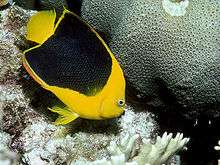Rock beauty
The rock beauty (Holacanthus tricolor) is a species of marine angelfish of the family Pomacanthidae. Other common names include corn sugar, coshubba, rock beasty, catalineta, and yellow nanny.[1]
| Rock beauty | |
|---|---|
 | |
| Scientific classification | |
| Kingdom: | |
| Phylum: | |
| Class: | |
| Order: | |
| Family: | |
| Genus: | |
| Species: | H. tricolor |
| Binomial name | |
| Holacanthus tricolor (Bloch, 1795) | |
Description
The adult rock beauty is mostly yellow, turning blue toward the tail. The tail itself is yellow. The pectoral fins and ventral fins are yellow, and the lips and the edges of their dorsal fins and anal fins are dark blue. The adult measures up to 10 inches (25 cm).
Diet
The rock beauty feeds primarily on sponges. It may also eat tunicates, jellyfish, and corals, as well as plankton and algae. In home aquaria, keepers have had limited success with diets of meat- and algae-based fish foods. The fish requires sponges to survive.
Distribution
The fish inhabits reefs from the tropical western Atlantic Ocean to the northern Gulf of Mexico. It can be found at depths between 3 and 92 metres (9.8 and 301.8 ft).
Reproduction
The adults stay in pairs year-round, perhaps suggesting a long-term monogamous bond. The pairs reproduce by rising up in the water, bringing their bellies close together, and releasing clouds of sperm and eggs. The female produces 25,000 to 75,000 eggs per day, and up to ten million eggs during each spawning cycle. The eggs are transparent, buoyant, and pelagic, floating in the water column. They hatch after 15 to 20 hours into larvae that lack effective eyes, fins, or even a gut. The large yolk sac is absorbed after 48 hours, during which time the larvae begin to develop normal characteristics of free-swimming juveniles. They feed on plankton for 3 to 4 weeks, reaching 1.5 to 2 centimetres (0.59 to 0.79 in) in length, and then settle on the bottom as juveniles.
References
- Pyle, R., et al. 2010. Holacanthus tricolor. In: IUCN 2012. IUCN Red List of Threatened Species. Version 2012.2. Downloaded on 05 June 2013.
External links
- 74美國石美人(臺灣、香港)Holacanthus tricolor(Rock Beauty angelfish) on YouTube
- Froese, Rainer and Pauly, Daniel, eds. (2006). "Holacanthus tricolor" in FishBase. June 2006 version.
- Photos of Rock beauty on Sealife Collection
| Wikimedia Commons has media related to Holacanthus tricolor. |
| Wikispecies has information related to Holacanthus tricolor |
